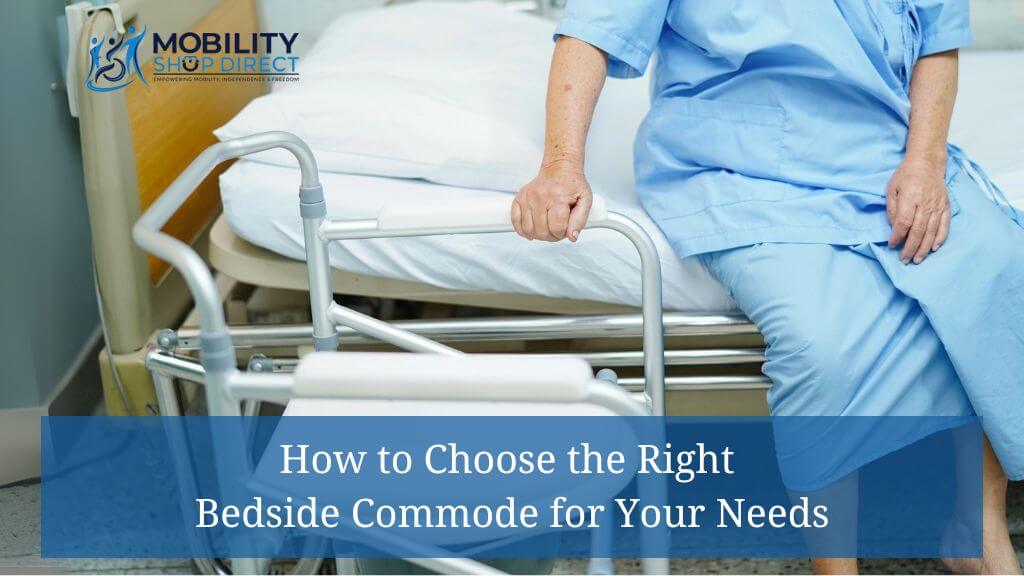What should I look for in a bedside commode? At first glance, it may seem like a simple decision, but choosing the right commode can have a big impact on comfort, practicality, and even emotional well-being. For individuals needing extra support, the right bedside commode can help restore confidence and dignity in daily routines. Whether you're shopping for yourself or a loved one, knowing the options and features can make all the difference.
Modern bedside commodes are designed with safety, versatility, and comfort in mind. From weight capacity and adjustability to portability and ease of cleaning, there’s a lot to think about. If the choices feel overwhelming, this guide will break things down step-by-step so you can make a clear decision.
We’ll walk through the types of bedside commodes, what features to look for, and a peek at where the design is heading, so you can choose with confidence.
Table of Contents
- Why Does It Matter?
- Who Needs a Bedside Commode?
- Types of Bedside Commodes
- Key Features to Look for in a Bedside Commode
- Additional Factors to Consider
- Benefits of Choosing the Right Bedside Commode
- Future Innovations in Bedside Commode Design
- Frequently Asked Questions About Bedside Commodes
- Key Takeaways
- Conclusion
Why Does It Matter?
Selecting the right bedside commode isn’t just about convenience. It can improve quality of life by making daily routines safer and more comfortable. For people with limited mobility, it reduces the risk of falls. For caregivers, it makes support tasks more manageable.
Whether you're caring for an older adult, helping someone post-surgery, or dealing with frequent nighttime needs, the right commode can make a real difference. It shifts the experience from a medical hassle to something that supports everyday independence.
Who Needs a Bedside Commode?
Plenty of people benefit from a bedside commode, depending on their situation. Common groups include:
- Elderly individuals with limited mobility: Getting to the bathroom can be risky. A nearby commode helps reduce falls and adds convenience.
- Post-surgery patients: Recovering from operations like hip replacements? A commode saves steps and energy.
- People with overnight or frequent bathroom needs: If you’re up often or managing a medical condition, having a commode close by makes life easier.
The key is choosing one that fits both physical needs and the home environment. Let’s look at your options.
Types of Bedside Commodes
Standard Bedside Commode
This is the most basic and widely used style. It looks like a chair with a bucket under the seat. These are practical, straightforward, and easy to use. Just make sure to check the weight capacity—most hold between 110-160kg.
Bariatric Bedside Commode
Built for heavier users, these have wider seats and stronger frames. They can support up to 300 kg and offer extra stability. If durability and safety are top priorities, this is the type to consider.
Portable Bedside Commodes
Lightweight and often foldable, portable commodes are great for travel or small spaces. They’re still sturdy, just easier to store and move. Perfect for anyone needing flexibility.
Drop-Arm or Adjustable Bedside Commodes
These are made for easier transfers, especially from wheelchairs. The drop-arm design helps with side access, and height adjustability means better posture and safety. They’re ideal for users who need help moving on and off the seat.
Multi-Functional Bedside Commodes
These double as raised toilet seats or over-the-toilet frames. That kind of versatility is great if your needs might change. You can read more about this in our post on different types of bedside commodes.
Key Features to Look for in a Bedside Commode
Weight Capacity and Safety
Always check the weight rating. Pick one slightly above the user’s weight for safety and longevity. Also look for features like non-slip feet and secure armrests to help avoid falls.
Adjustability for Comfort and Posture
Height matters. A commode that adjusts to the user’s natural sitting position makes it easier to stand up and sit down without strain.
Portability and Space-Saving Needs
Living in a small apartment or planning to travel? Go for a folding model. They take up less space and can be stashed away when not in use.
Material and Durability
Metal frames tend to last longer than plastic ones. Look for rust-resistant finishes if you’ll be cleaning it regularly. It’s also worth considering how often it will be used and in what environment.
Additional Factors to Consider
Ease of Cleaning and Maintenance
Choose a design with smooth surfaces and removable buckets. Features like splash guards and commode liners help too. For detailed cleaning steps, here’s a helpful guide on cleaning and maintenance.
Sizing and Fit
Measure your space before buying. The commode should fit without crowding the room. Also, make sure the seat is wide enough to sit on comfortably.
Accessories and Add-Ons
Things like padded seats, armrests, and liners can add comfort and convenience. These extras might seem small but can really improve daily use.
Benefits of Choosing the Right Bedside Commode
- Improved safety and comfort: Prevents falls and supports smoother movements.
- Better quality of life: Promotes independence and eases the caregiver’s job.
- Cost savings: A durable, multi-use commode means fewer replacements over time.
You can learn more about these benefits in our post on the safety benefits of bedside commodes.
Future Innovations in Bedside Commode Design
- New materials: Expect lightweight but sturdy builds, with antibacterial coatings.
- Tech integration: Some upcoming models may have sensors that alert caregivers if assistance is needed.
Frequently Asked Questions About Bedside Commodes
-
What is the standard weight capacity for a bedside commode?
Most hold between 250 to 350 pounds. -
Can a bedside commode be used over a regular toilet?
Yes, some models are designed to be used this way. -
How do you clean a bedside commode?
Wipe it with antibacterial cleaner, rinse removable parts, and check regularly for rust or wear. -
What features should I prioritize for elderly users?
Look for non-slip feet, adjustable height, and a sturdy frame with armrests.
Key Takeaways
- Pick the right weight capacity: Bariatric models are built for higher needs.
- Adjustability is key: Height settings help with safe, comfortable use.
- Space matters: Foldable designs are great for tight living spaces.
- Go for durable materials: Metal frames with rust resistance last longer.
Conclusion
The right bedside commode is more than a convenience, it supports safety, dignity, and independence. By focusing on features like weight capacity, adjustability, portability, and cleaning ease, you’ll be in a much better position to choose one that really works for your situation.
Need help browsing options? You can explore a full range of models at our bedside commodes collection.



